#Caligari Legacy
Photo


#Laris Caligari#Oberon Caligari#Eoin Nox#Caligari Legacy#ts4#the sims 4#the sims 4 discover university
15 notes
·
View notes
Text

BRONTE'S COMFORT LIST
comfort food(s): pizza, tortas “ahoga perros”, corn “at-home-street-style”, nachos, chicken nuggets, beef taquitos, lentils, etc.
comfort drink(s): honestly? water. lol horchata and coca cola.
comfort movie(s): the exorcist, the terminator, the exorcism of emily rose, split, drive, foxfire, brainscan, constantine, candyman, the rocky films, the ip man films, the star wars (eps 1-6 & rogue one) films, school of rock, donnie darko, 8 mile, the crow, gus van sant’s last days, jeepers creepers, awake, secret window, pet sematary (1&2), rosemary’s baby, my soul to take, child’s play, psycho, the texas chainsaw massacre (remake), jaws, scream, the craft, the lost boys, edward scissorhands, beetlejuice, the matrix, american werewolf in london, the cabinet of dr caligari, zodiac, red dragon, rambo/first blood, insidious (1,2&5), the Halloween franchise, the Friday the 13th franchise, the a nightmare on elm street franchise (with remake), the evil dead (& remake), gremlins, ghostbusters (1&2), silent night deadly night, the amityville horror, my friend dahmer, murder by numbers, sinister, twister, twisted nerve, natural born killers, behind the mask, the sixth sense, Alice in wonderland, peter pan, dumbo, bambi, the land before time, the sword in the stone, the aristocats, the beauty and the beast, etc.
comfort show(s): bob’s burgers, dexter, sons of anarchy, 21 jump street, renegade, stephen king’s rose red, salem’s lot, american horror story (first two seasons), tales from the crypt, daria, catfish, the twilight zone, criminal minds, the x files, the green hornet, etc.
comfort clothing: ripped jeans, baggy (oversized) tees, baggy (oversized) hoodies, cargo pants and shorts, plaid button-ups, sweatpants (joggers), overall pants, long socks, sneakers, combat boots, trench coats, “grandpa” or “80s dad” sweaters, bunny slippers, sandals with socks, the occasional dress or romper, etc.
comfort song(s): what’s up (4 non blondes), stan (eminem), vampires will never hurt you (mcr), darkside (bring me the horizon), disgusting semla (morbid), one (metallica), the hunger (distillers), burn (the cure), oye mi amor (mana), afuera (caifanes), jeremy (pearl jam), numb (linkin park), nightcall (kavinsky), etc.
comfort book(s): red dragon, the wasp factory, frankenstein, damien echols’ autobiography, darkly dreaming dexter, joyland (sk), into the wild, the jedi quest book series, the i am not a serial killer book series, the crow (comic), the exorcist, salem’s lot, drive, constantine (film novelization), hellblazer (comics), per yngve ohlin (clem petit-huguenin), lots of old dh darth vader comic runs, etc.
comfort game(s): battleship, guess who, perfection, operation, ouija, “baseball” (card game), checkers, chinese checkers, puzzles, dark lore, the golden ticket, duck hunt, hog.warts legacy, etc.
stolen from: @walkeddeath.
framing: @k4rlsson, @freakarus, @strigoix / @miercolaes, @morb1dg1rl, @wastrels, @liraspins, @likeorpheus, @stringmastery, @hangtenn, @nuks, @andtheylive, @absentpublic, @00sgoth, @punkzombie, @popularmxnster, @mrdelroy, @allevils, @getslashed, @bloodykneestm, @helvehte, @helltoraise, @facepeeled, @cheekypriest, @v011d, @roznrot, @poisonedfire, @butscrewmefirst, @notimminent, @sweets1n, @daensuse, @horrorface, + you.
25 notes
·
View notes
Text
Fancuries FYC, Heck Yeah!
Hi, folks! I hope you all are doing well. I’m InfiStudios, friendly neighborhood jumping spider and fanseries fanatic, and I’m so, so excited for this year’s Fancuries. I always love seeing everyone’s amazing creativity, and because this year is the first where I’m actually participating, I finally have a chance to babble about my own fanseries.
Speaking of my own work, the bulk of it is my Halloween fanseries. They’re an annual tradition for me, and I consider them my main fanseries.
HORRORIFFIC PRETTY CURE
Horroriffic is the first of the Halloween fanseries. Its motifs are classic monsters, light, and Victorian/gaslamp aesthetics, and its core themes are power, connection, and legacy.
It has an info doc that’s very much under construction here if you’d like to read more about it!
HORRORSHOW PRETTY CURE
The second of the Halloween fanseries, Horrorshow has films as its core motif and draws a lot on 1950s aesthetics as well, and its themes are treating others and yourself with kindness. It follows Ethel Bleak, a horribly anxious star student who works part-time at the Caligari Film Library…a job that gets far too interesting when an accident sends the malevolent spirits housed within cursed films on a destructive rampage through the city of Hitchworth. Luckily, there’s a solution to this. Using the power of the three remaining Curses, Ethel and two of her co-workers - annoying, cruel know-it-all Cebe Wood and laid-back, sarcastic Shane Tamboli - can transform into warriors called Pretty Cure and fight back against the monsters.
Its characters have toyhou.se pages here.
MONSTROSITY PRETTY CURE
The third of the Halloween fanseries, Monstrosity’s core motif is monsters under the bed, and its core themes are the bonds between people and the idea of community.
Pellinore Valiente Denton was only six when the tip of Mount Etna exploded, sending a brilliant beam of light into the sky and calling the monsters out of the shadows. She’s lived her whole life in a strange world, a world lit every waking moment by fluorescent lights and constant, thrumming fear. In the midst of all this, her parents have moved back to their hometown of Huerta, TX in order to work on some sort of project, which Pellinore isn’t over the moon about - she’s tired of having to say goodbye to every friend she’s ever made. Fortunately for her, though, she’s about to make another one. Not two days into their stay there, Huerta throws off its sleepy small-town guise. In the middle of a celebration of Dia de los Muertos, the lake the community borders erupts in exactly the same way Mt. Etna did. It showers the community in a strange light, brings a rainstorm that lasts for days on end, and rockets the populace into a new state of terror - terror that turns out to be well-founded, because soon after the town is attacked by a bizarre monster that can walk in the light and resembles a member of the community. Pellinore is terrified, but somehow, she knows she can help fight it. Drawing on her love of magical girls and a new kind of power, she transforms into a warrior known as Cure Weaver.
The only catch? Her powers called a monster to her - Aracan, a cocky smart-aleck who’s Pellinore’s opposite in every way…and also, apparently, her partner as a Pretty Cure. Now, Pellinore finds herself under new pressure - not only must she succeed as a student and make new friends, she must hide Aracan from the populace, deal with the monsters, and unravel the mysteries of Huerta.
Its characters have a work-in-progress toyhou.se page here.
I also draw! I'm a traditional artist (digital art scares me), and I really love it. Here are some examples of my work!

Horroriffic's vampiric team leader, Ifiok/Cure Rise

Her teammate, Cure Whirlpool...
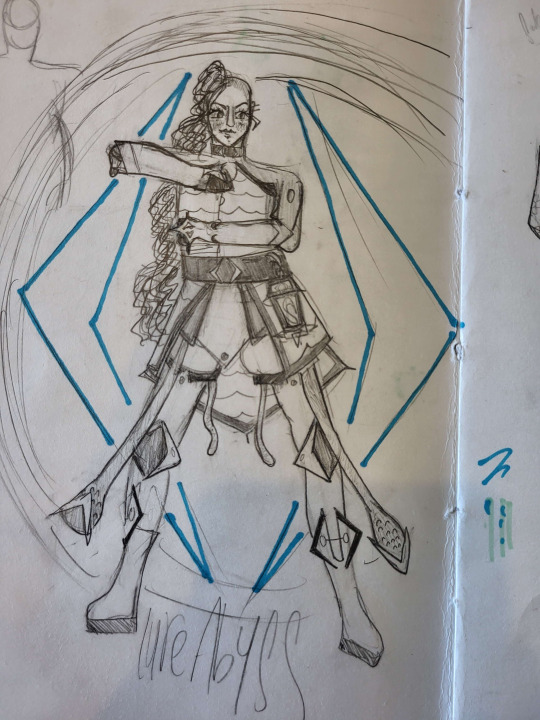
...and Whirlpool's successor, Cure Abyss!

The members of Team Horrorshow! From left to right, Cures Haunting, Abduction, and Verdant
Thank you so much for your time; I so appreciate it! I'm so excited to see what this year's Fancuries have to offer, and I hope you have a lovely day!
9 notes
·
View notes
Text
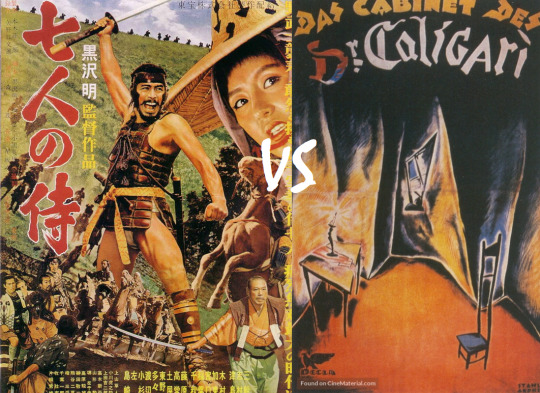
Seven Samourais:
What can even be said? Directed by the visionary Akira Kurosawa, who pioneered many of the most foundational filmmaking techniques used to this day. The film is exciting and compelling, every shot is art, and its legacy on the industry is yet to be overshadowed. It consistently makes top ten on ‘best films of all time’ lists to this day, rated the best foreign language film of all time by the BBC. All the actors are great, Toshiro Mifune is hot, the soundtrack by Fumio Hayasaka is iconic, and the film was technically magnificent for the time, with the techniques and effects frankly still blowing many modern blockbusters out of the water (ahem. marvel.) The film is also one of the most remade and reimagined films to date. Particularly of note is that The Magnificent Seven, one of the most famous films of all time (and criminally much more well-known than Seven Samurai) is explicitly a direct remake of Seven Samurai with the setting swapped. Frankly it’s no contest. All of Kurosawa’s films are brilliant, and were massively influential for their own reasons, but Seven Samurai is such a seminal piece of cinematic history that not including it would be nigh a crime.
Seven rōnin are hired to protect a village from bandits. This film has such a classic set-up and has been remade several times over (See: The Magnificent Seven, The Invincible Six, A Bug's Life honestly...). However, I personally think the original did it best. It's got the best action, the best characters (Toshiro Mifune my beloved), and just the best general direction. For a film that's over 3 hours, not a second of it feels wasted.
The Cabinet of Dr. Caligari:
Arguably the first TRUE horror film! The Cabinet of Dr. Caligari is a majorly influential German silent film from 1920, very easily streamed all over the place including YouTube! It had a tremendous impact on German and American cinema, especially in horror and later noir films, and featured fantastical elements of surrealism in its depictions and architecture that are incredibly endearing. The film is a tale of love, hypnotism, and murder. Fantastic plot twist for an early film, and Cesare is very very gender.
11 notes
·
View notes
Text
man, now that I've read about it, I'm thinking about the original planned ending to "caligari," where francis and jane contemplate a plaque reading "here stood the cabinet of dr. [caligari]/ peace be to his victims/peace be to him!"
and like. god, there's so much to think about here. what sort of epilogue is this for the characters? this plaque is all that remains of the events of the few short nights that showed them the death of innocence and presumably scarred them forever. for francis, this may leave him to think, "what now?". he solved alan's murder, and confronted the killer. he's won. but is he feeling any sort of victory now? without alan, it's just him and jane- and he nearly lost her, too. every time they meet since the murder, they will be haunted by his absence. he knows that caligari traveled around; had he not stopped him, it wouldn't have just been holstenwall grieving its dead. peace be to him? why should he deserve peace, after caligari targeted francis' friends to ensure that he would not know peace? is this plaque his reward, and all that remains of alan's legacy?
and for jane, perhaps she's thinking that she was nearly counted among his victims- had an entire town not been willing to kill for her; she, too, has power in her powerlessness. will she ever be at peace, either? before, francis and alan agreed for her to decide which of them to marry- but now alan is gone. will she have to marry francis, or will the other men in town come knocking on her door saying that they helped vanquish the creature that abducted her, and that she should marry one of them instead? and yet, she remembers caligari's leering gaze as he lured her into his tent- the same hungry way he gazed at cesare. "peace be to his victims"... but doesn't that include cesare, too? how would she feel about that?
peace be to his victims.
these two survived. they still have each other.
peace be to him.
it's over. it's over. it's over.
7 notes
·
View notes
Text
"The Henpecked Duck": A Morbidly Intensive Reflection (Part 1)
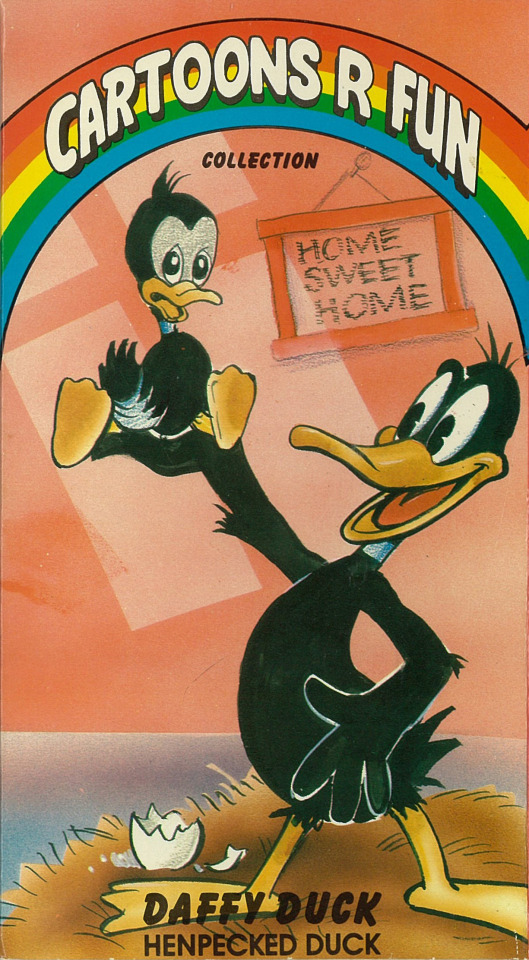
(image: vcrfromheck.tumblr.com)
What you see before you is a facsimile of a VHS tape my grandmother mysteriously owned in the early nineties. The tape was specifically for my older sister and myself in the hopes that it would pacify us if we got too rowdy. My grandmother eventually donated it once we were older....without asking my permission. We're not on speaking terms at the present moment.
The videotape was entitled "Cartoons R Fun", which is embossed on a rainbow you might see arched over Mount Ararat post-Deluge. Indeed, cartoons "r" fun, if you forgive the juvenile usage of a homophonic letter as a plural present tense of the verb "to be".
Daffy Duck, proudly standing on a tan blob with thin pencil lines to signify a nest (one that's peacefully floating on a violet overcast sky), is holding a freshly-hatched, over-sized duckling in his hand, as a quaint HOME SWEET HOME knick-knack looks on lovingly. Not an accurate depiction of the advertised short, but we'll cross that poorly-drawn bridge when we get to it. However, the tilted Dr. Caligari-esque shadow of a window in the background is indicative of the mood of the short in question.
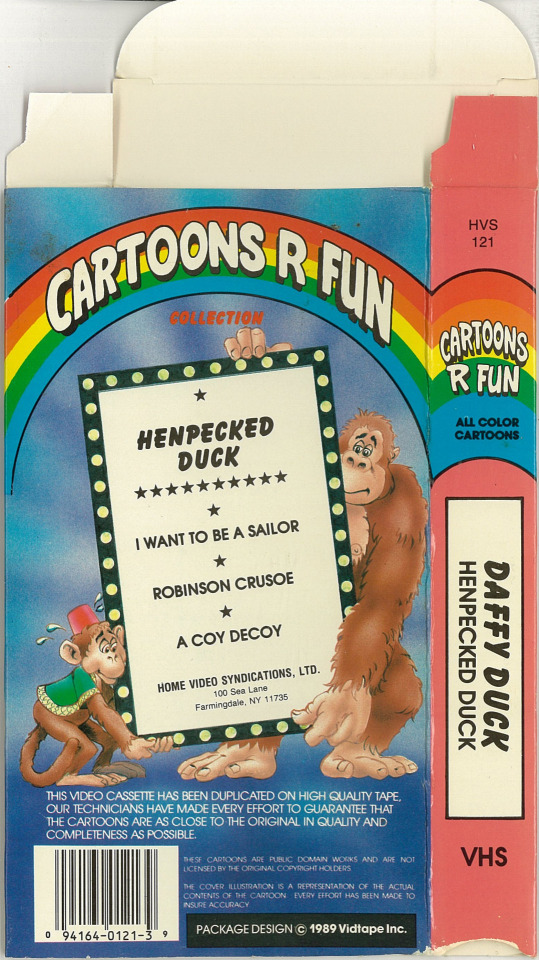
(image: vcrfromheck.tumblr.com)
The tape was top-loaded with four chortle-filled public domain follies produced between 1937 and 1941. Those amusements being, The Henpecked Duck, I Wanna Be a Sailor (see?), Robinson Crusoe Jr., and A Coy Decoy, as the tape advertises in a tacky brush font, on a showbiz marquee being lugged about by two (presumably) unpaid simian laborers, "Henpecked Duck and MANY MORE..." ("Henpecked Duck", as you might have noted, is missing a definite article, adding to the lackadaisical charm of the proceedings).
These tapes were not the best quality. I know this because the last ten seconds of A Coy Decoy are cut out, missing the all-important punchline of Daffy procreating with a toy duck. (it took me fifteen years to discover this, thanks to the miracle of www.youtube). The tape was too short so it ended on a blue screen of death. The shorts were not in black-and-white, nor are they in color, as the box cover deceptively advertises with its omnipresent "all color" rainbow. Rather, it's presented in a dusty sepia-tone (the shorts fell into public domain so I can incorrectly presume that the sepia is an after-effect of neglected film preservation). This in itself is not a bad thing. I like my cartoons to look like the first act of The Wizard of Oz. They look pristine and well-preserved, like something perfectly bronzed to a fine sheen. If I were to flick my finger, the film would make an audible 'ding'.
Anyway, the cartoon that sticks out the most (obviously, it's the main feature) is The Henpecked Duck. Released on August 30th, 1941 (about three months before the United States entered World War II....this was back when the epidemic of housewives battering their husbands with frying pans was of more pressing concern than Hitler), it was directed by Bob Clampett (the insane bad boy of the Warner Bros. animation department) and written by Warren Foster. It concerns a married Daffy Duck getting into some hot water after accidentally misplacing their unborn child. It is an intense piece of marital melodrama framed through the irreverent filter of Looney Tunes.
I've always been drawn to it. Not in any sort of substantive way (I'm not a child of divorce or anything of the sort), but in the sense that it's a piece of media that I've consumed to such a inordinate degree that it gains a kind of vague meaningfulness. It's also an overlooked short that I feel should have a little light drawn towards it, as a way of saving it from the gaping maw of obscurity. And since every piece of media has been discussed to death on the internet, I thought I could annoy you and place my minuscule stakes on this 7-minute short from 1941. Hopefully, this will be the final, definitive word on the subject. My legacy depends on it.
Let's examine this short in embarrassing, navel-gazing detail, shall we?. Not just gazing, mind you, I mean gripping my hairy belly between my two mitts and, depending on how much bendable flexibility I still have stored in my rapidly fading youthful figure, blow into my umbilicus scar, until you hear an audible plop-plop-plop.
(note: I put a sepia filter on these black & white screencaps to simulate how I experienced The Henpecked Duck as a child.)
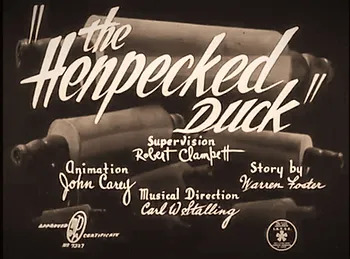
WAH WAH WAH WAH WAHHHHHHHHHH. Doodly-doo, doodly-doo, scattily woo woo woo woo doo, doodly-doo, doodly-doo, doo doo. (That was obviously Mendelssohn playing over those overlapping rolling pins.)
The short opens on darkness, a cacophony of plaintive whinging blooms on the soundtrack. People are demanding divorces left and right. The camera suddenly springs back from the darkness to reveal the shadowy entrance of what appears to be a ramshackle barn or chicken coop. It's hard to tell considering the entrance takes up the entire frame. The lack of a proper wide establishing shot and the numerous disembodied voices only adds to the feeling of anxious dislocation. A wooden plank leads forbiddingly into the darkness. A crudely written sign hangs over the entrance, "Court of Inhuman Relations."
(A small reservation I have is the sound mixing on the voices being too loud. You can almost hear Carl Stalling's score which, from the few strains that I'm able to eke out, carry an foreboding menace).
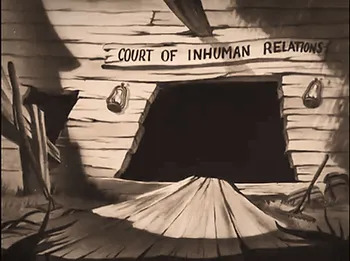
Transition to a close-up of Porky's gavel (Porky is presiding over this raucous kangaroo court) rapping on the judge's stand with an aggressiveness too intense for the viewer to even process in these first few seconds. The camera rapidly pulls back from the gavel, to a wider shot of Porky, to an extreme low-angle long shot of the aisle as the crowd quiets down. Already, we have two instances of the camera springing back rapidly from close-ups to establishing shots, as if the cameraman was suddenly dropped out of the sky and is quickly trying to adjust to the foreign scenario he has just encountered. Needless to say, it has a startling effect.

Porky Pig announces the first case of the day: Duck vs. Duck. He orders Mr. Daffy Duck to approach the stand. There is a shot from Porky's perspective where we can see the entire courtroom with Porky's gavel and water jug hugely prominent in the foreground (they take up almost half of the frame, symbolizing the firm grip that the rural judicial system has even over the lowliest waterfowl). The courtroom is a surreal scene indeed. It consists of barnyard animals, from a duck with an abnormally long neck, to a dopey-looking black mutt, to a fat hog sitting uncomfortably on one of the benches, and a snoring elderly hen (who provide a few visual gags near the end of the short).
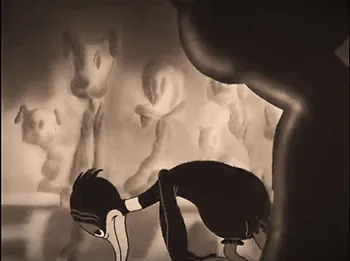
Daffy Duck slowly shuffles up the aisle. His overbearingly grim disposition are not unlike a POW during the Bataan Death March, with his slouched posture and hangdog eyes. Stalling's score is just as slow and methodical; a prominent trombone emitting a onomatopoeic 'wah-wah'. He walks past the onlooking crowd, eerily still and blurred in the background. The few figures he walks past in the foreground are featureless and emit a dull glow like bronze statues. The stillness of the crowd make Daffy's isolation unbearable.
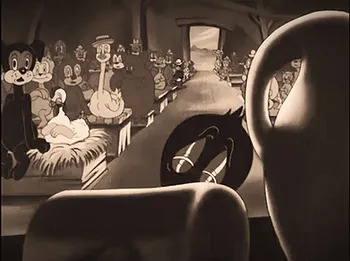
Daffy approaches the stand as Porky calls up Mrs. Daffy Duck. Before I move on, I must point out a glancing detail and a naggingly under discussed trope of old 30's-40's cartoons: glassy eyelids. Daffy blinks a few times as he looks up at Porky on the stand. His eyelids have a glassy, polished tint, as if run through a shoe buffer. It is an unsettling detail, adding to the surreality of the mise-en-scène.
Mrs. Duck, unlike Daffy, charges up the aisle with a straw boater cocked at an angle, in the manner of old-time gangsters, and a ridiculous poofy ball bouncing from it (what else could one call it but a 'poofy ball'?), giving off a unexpectedly violent energy. Unlike the pathetic trombone used on Daffy, Stalling utilizes blaring trumpets, giving her entrance a martial air. I must amusingly point out that Mrs. Duck is essentially Daffy with a hat and skirt (no pronounced Minnie Mouse eyelashes either).

Shot from an intense low angle close-up, Mrs. Duck, the perennial battle-ax stereotype, chants the four most iconic words of my salad years: "I WANT A DIVORCE! I WANT A DIVORCE!" It's amazing how a single moment can be so easily etched into such an impressionable young mind. The immediacy of it (no one in real life can shout banal declarations with such dramatic relish) and its startling bluntness struck me as unusual in a Looney Tunes short. It's so dramatically heightened when compared to the more relatively light-hearted tone of other Warner Bros shorts. Though as I've grown older, I can't help but see a bit of the parodic in it; melodrama bursting to the brink of burlesque. Not to mention the almost shrill string section that accompany these outbursts.

Mrs. Duck rains a flurry of invective on Daffy (with a couple of thwacks on the head from her vanity parasol). We get a closeup of Daffy, where we get some fine acting on his end. As she twaddles on, he winces and grimaces, being verbally battered into submission. At one point, she commands him to respond. In a subtle bit of comic acting, Daffy opens his beak in an air of sarcasm (noted by the over-exaggerated intake of breath), and just as he's about to speak, he automatically snaps his beak closed just as she tells him to shut up. Henpecked, indeed, if you are unironically tickled by the avian-adjacent pun of its title.
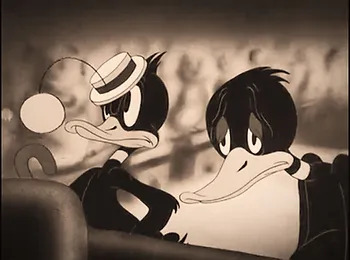
The Honorable Porky Pig orders Mrs. Duck to calm herself and explain the origins of this particular domestic strife. I must point out that as Porky speaks, we get a two-shot of Mr. and Mrs. Duck. It's almost a still shot, except for the poofy ball on her hat, which slowly bounces until it comes to a stop, like a toy soldier winding down. It's a minute detail that adds to her energetic characterization. Even when she's still, she's moving.
At this point we are launched into the dramatic thrust of the short. We are spirited backward into the past by way of flashback. This is where the real fun begins.
We arrive at the abode of the Ducks (we get no exterior establishing shot) where silhouettes (projected on a wall of two by fours, adding to the rural decrepitude) of the couple hover over a nest with a plump half-oval of an egg nestled on top. A framed embroidered artwork of the words "Home Sweet Home" adds a touch of ironic bonhomie (the music of "Home Sweet Home" is gently playing in the background). Mrs. Duck is lovingly instructing Daffy to manually incubate the egg while she goes to visit her mother. She walks past the camera and out of frame. She then violently (and comically) juts her face back into frame (her beak thrusting like a dagger) with an idle threat of strangulation (the music suddenly turns menacing).

Daffy sits obediently on the nest, replying to every matrimonial trumpet blast with the soft-spoken yet seethingly sarcastic, "Yes, m'love." Daffy's comic acting is brilliant here. The frozen smile, the disingenuously coy eye-blinking, the listless, non-committal head nodding. Not to mention Carl Stalling's expressive soundtrack, with Mrs. Duck's dialogue highlighted by stormy percussion and Daffy's highlighted by softer staccato variations on the "Home Sweet Home" theme. When Mrs. Duck leaves, Daffy gets up off the nest and vents out his frustration, mocking her with multiple "Yes, m'love's" (we also get a sense of the wide space of their sparsely furnished house, giving it the feeling of a stage). The omniscient Mrs. Duck suddenly bursts through the door screaming, "What's that?!" Daffy springs back to the nest (the music oddly spring-like itself), a eerie moment of silence before Daffy quietly, obediently says, "Yes, m'love." Mrs. Duck leaves.

After an indeterminate passage of time, Daffy is still sitting on the egg (his arms uselessly crossed as opposed to the demure limpness he expressed when the missus was about), looking bored and restless. Carl Stalling's score here is particularly striking, giving this little interlude a weird note of foreboding. Daffy decides to examine the egg, shake it, and balance it precariously on his digit. How I relate to Daffy's fascination! There is something miraculous about that ovoid vessel. Its perfect shape and dimensions. Its firm yet fragile shell, its smell reminiscent of sticking your hand out of a speeding car window, then smelling the palm once retracted. When you put a knife to a boiled egg, you see its uniform circularity with its white outer layer and its yellow yolk (sans zygote, of course).
Daffy, in a fit of pure sponteneum, lays to rest the age-old chicken-or-the-egg conundrum by rendering it moot. We get an extreme close-up of his hand fondling the egg then pressing the egg between his palms until it is squeezed out of existence. Even Harry Handcuffs couldn't pull off a feat of such trickery. Daffy, standing confidently on his nest like a master sleight-of-hand, chants some magical hoodoo ("Hocus pocus, flippety flam, razzmatazz, and alacazam!") and the egg reappears between his two fingers (with an amusing "boing", clearly a human's voice).
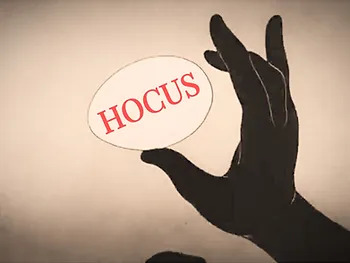
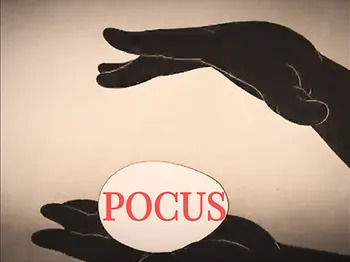

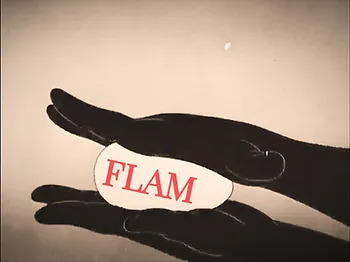



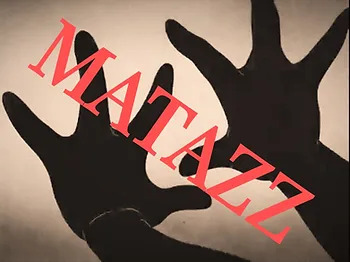
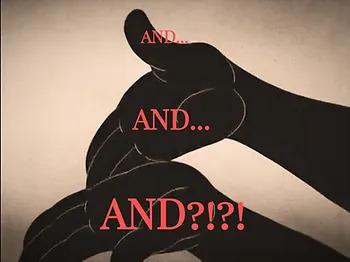

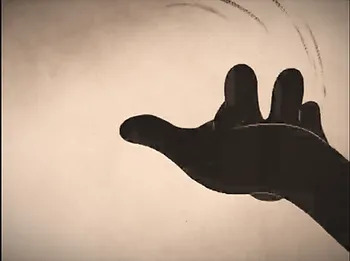
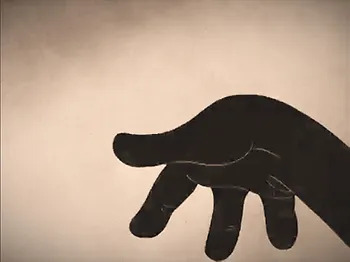
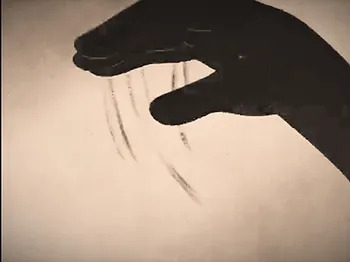
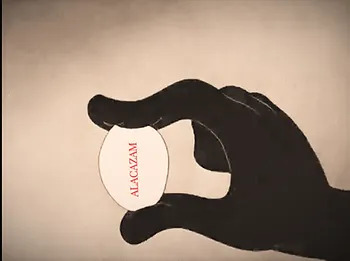

He is amazed by his newfound abilities and addresses the audience with cross-eyed relish. Notice that the borders of the frame move inward so there there is a thick black outline underneath and to the sides. We cut to a wide shot of Daffy stepping off his nest (making a hearty reference to Major Bowes, an old "Gong Show"-esque radio program) and then stepping forward and out of the frame, his feet planted on the black. It's meant to be a fourth-wall gag but it's awkwardly executed because you notice the frame retracting in preparation for the gag. Frankly, I'm not quite sure why they had to break the fourth wall at that particular moment.

Daffy makes the egg disappear again. I must point out Stalling's lovely rendition of Juventino Rosas' waltz, "Sobre las Olas" (Over the Waves), a calming Wurlitzer standard, but like its title, suggests that Daffy is heading into choppy waters. He repeats the magic words and, lo and behold, the egg does not reappear. Daffy's eyes bulge out of his head and looks at the audience, shrugging with uneasy reassurance. He tries again. Same result. The tempo of the scene steadily grows faster (along with the score) as Daffy desperately tries to make the egg reappear. Daffy is now hysterically banging the floor, imploring an indifferent deity to make his unborn child whole again. Of course, it wouldn't be Looney Tunes if they didn't make Daffy break the fourth wall ("Say, is there a magician in the house?"), then immediately falling back into character (now that felt like a more appropriate fourth-wall gag than the previous one). A clock ticks on unrepentantly.
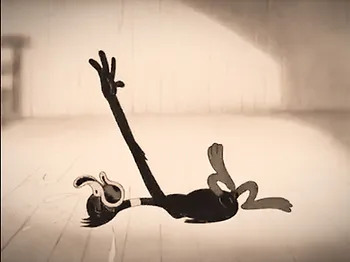
(continued in Part 2...I hoped to fool you and claim it's Part 1 as a dramatic cliffhanger for this intense marital thriller...it's only because Tumblr allows 30 images per post so I had to break it up into two parts....I apologize if I have completely demystified this [allegedly] mature and thoughtful examination)
5 notes
·
View notes
Text
Exploring Lotte Reiniger's 'Cinderella' Through the Eyes of a Silhouette Animator and Feminine Depth
(5 minutes reading)
By Sofi Ojeda

Lotte Reiniger, a trailblazing German animator renowned for her pioneering work in paper silhouette animation, has had a profound impact on the animation industry. Inspired by ancient Asian performances, Reiniger's legacy extends beyond her creation of the first full-length animated feature film, "The Adventures of Prince Achmed (1926)".
Today, we explore one of her lesser-known yet highly significant earlier works, "Aschenputtel" (Cinderella), crafted in 1922. This journey allows us to appreciate Reiniger's artistic brilliance and invites us to delve into the deeper layers of meaning within this classic fairy tale.
Understanding the Narrative
An intriguing element that I loved of this 12-minute short film lies in its opening sequence, where we witness Reiniger's hands meticulously crafting the paper main character Cinderella. Notably, Reiniger imbues the scissors with a character of their own, introducing them as a threat to Cinderella. This powerful and symbolic commencement aligns seamlessly with the film's overarching narrative:
"Cinderella" is a young woman who manages to defy formidable challenges and secures an invitation to a royal ball, ultimately winning the affection of a prince, or as she eloquently phrases it:

(Indeed, she also created these stunning English-written cards.)
Silhouette Animation Technique
Reiniger employed a frame-by-frame photography technique using multiple layers of cut-out paper. By adjusting opacity and composition, she crafted an illusion of depth in a multiplane camera—a technique later adopted by Walt Disney. Adding depth to the character designs through exaggeration, shape language and acting. Even the inanimate objects in the film are imbued with a distinct German expressionism style—distorted yet still legible. Remarkable for its time and the work of a single individual.
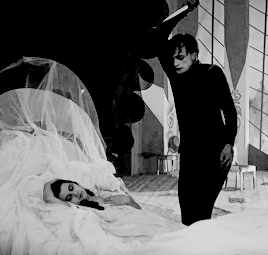
(German expressionism movie: The Cabinet of Dr. Caligari (1920))
Feminine Insights
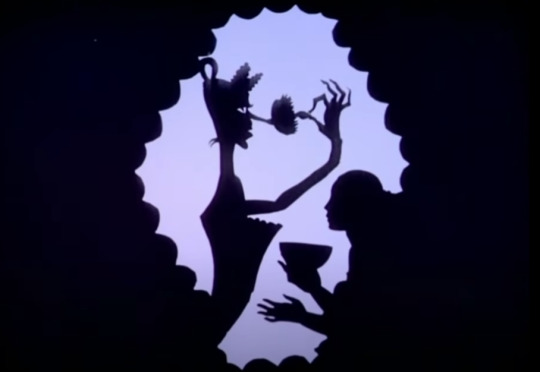
Reiniger's "Cinderella" isn't just a retelling of the classic fairy tale—it's an exploration of femininity, vanity, and competition among women. The film uses humor, such as the comically exaggerated eye movements of characters, to ridicule vanity. It reflects a historical perspective where differences in femininity were exploited for competition. Today, we recognize that there's no one way to be feminine, and no one is better or worse for their choices.
youtube
In the tale, her stepsister goes to extraordinary lengths, even resorting to cutting a part of her own feet to squeeze into Cinderella's shoe. This vividly illustrates how, in the past, cinema and television often portrayed the extraordinary measures women were willing to take to gain acceptance and validation from figures like princes or men in general.
While we may find her stepsister's actions unconventional, it offers a poignant glimpse into the immense hurdles women confronted in their quest to meet societal expectations, as they strived to fit into predefined molds and be valued accordingly.
A Lasting Legacy
Reiniger produced two unique adaptations of this story. The first (this one), is a silent version that closely follows the German Grimm rendition, replacing the fairy godmother with a magical tree. And the second was her 1954 version, which reintroduced the fairy godmother, along with components like a pumpkin coach and mouse footmen, despite the story's origin in Perrault's version.
Reiniger's "Cinderella" has left a lasting impact. It's intriguing to note that subsequent adaptations, including Disney's iconic version, have closely followed the story's original narrative. Cinderella's tale is one of the most remade stories in cinematic history, with over 100 adaptations on the big and small screens.
youtube
If you're curious to experience this classic work, here I attatched "Cinderella" short film (posted on YouTube), where its timeless charm continues to captivate audiences, just as it did nearly a century ago.
Bibliography
The Art of Lotte Reiniger, 1970 | From the Vaults (on youtube)
Movie: The Cabinet of Dr. Caligari (1920)
Blogs:
https://moviessilently.com/2018/03/18/cinderella-1922-a-silent-film-review/
https://www.skwigly.co.uk/100-greatest-animated-shorts-cinderella-lotte-reiniger/
http://www.screenonline.org.uk/people/id/528134/index.html
#2d animation#animation#writing#art#movies#1920sanimation#lotte reiniger#cinderella#movie critique#movie critic#short film#animation history#animationblog#Youtube
3 notes
·
View notes
Text
Anders als die Andern (Different from the Others) 1919
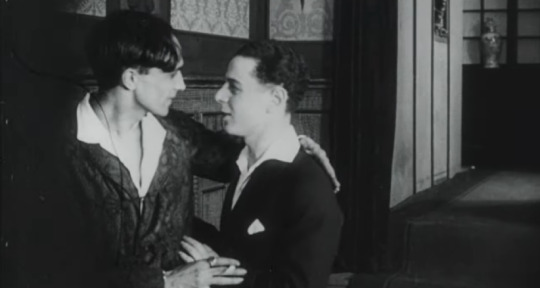
German Expressionism is a cinematic era that sees the depth of me.
Anders als die Andern especially, struck a chord lost within those depths. As, I myself am a Queer German person, the Queerness of this narrative as well as Conrad Veidt and Magnus Hirschfeld brought me so much joy. One of my favorite films of all time is Das Cabinet des Dr. Caligari but I only learned of Conrad Veidt’s legacy after a few rewatches and I only learned of his apparent open bi-sexuality after this week’s lecture- I was ecstatic. I almost felt like a failure to my (LGBTQIA+) community after learning about Magnus Hirschfeld for the first time in my life after that same lecture, and only after that learned of his historical prominence in sexology, let alone his coinage of the term Transsexual. All of this history was music to my ears, and then we actually watched the film. Anders als die Andern sung to me.
While this relatively simple narrative might not be typically aligned with the horror plots that often distinguish expressionist films, (i.e. Das Cabinet des Dr. Caligari) the political conversation aligns itself perfectly within the era. The silence that permeated Germany during 1919 was one born of necessity. §175 had been in place since 1871 and had forced Queer people to either hide themselves or be prosecuted for their identities. To be Queer and silent was to be safe. In the midst of this, the production of a film that not only serves as transparent Queer representation but also calls for the revocation of the very same §175 is a feat that cannot be understated.
While, the absence of footage that would have deemed this a feature-length film is deeply disheartening, I am grateful for the 50 minutes that we can witness. Even with its relatively narrow focus on white cis-gendered men Anders als die Andern retains a very important place within (Queer) film history and, for me personally, is a picture that makes my Queer little German heart want to sing.
0 notes
Text
Soul Reaver: The Tragic Masterpiece
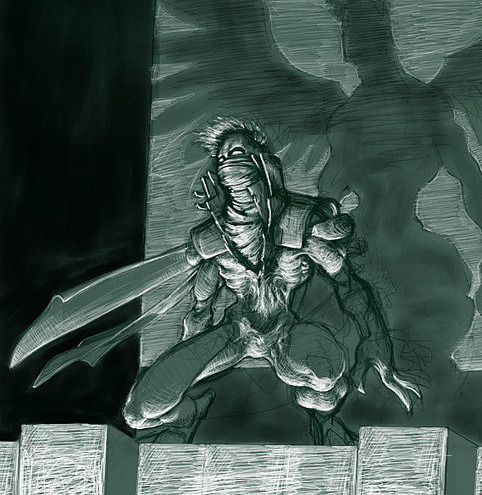
[Illustration: early Raziel concept art by Arnold Ayala]
[Article by Oasis Nadrama, 08/04/2022]
In 1999 came out a promising, inspiring video game, bound to become a legend on Sony's Playstation. It was the second title in the story-focused Legacy of Kain series, and according to a number of reviewers and passionate spirits, "may have been the most overly ambitious game ever".
So what makes it so special? Why, but why exactly is Legacy of Kain: Soul Reaver such a masterpiece?
DERELICT NOSGOTH: ORIGINALITY AND INSPIRATION
The first quality is the originality and sheer strength of the setting.
This is a post-apocalyptic steampunk arabic/ancient-civilizations-inspired post-medieval-fantasy organic horror gnostic multiple-planes-of-existence universe with a parallel spectral ecosystem.
Yeah, really. That's what we're going for here.
Soul Reaver takes an incredible quantity of ancient, classical, modern and contemporary influences, too many to list them all here; it takes Gnosticism, hindu myths; it takes the Paradise Lost poetry, Piranesi's etchings of imaginary prisons, Judaic, Christian, Islamic inspiration; it takes contemporary inspirations such as German Expressionism, Vampire the Masquerade, Necroscope, Atlantis fishmen and Xenomorphs and it weaves them all into its own unique mythology, also incorporating it into its very gameplay with the multiple clans and territories.
Raziel and the Spectral Realm alone are already aesthetical victories, both heavily influenced by the weirdest ideas (Raziel's vampire physionomy comes from Cesare in The Cabinet of Dr. Caligari, and his wraith form borrows from Vishnu, classical vampires and zombies as well as adding a variety of unique details such as the reversed Razielim symbol prolonging the black tears, or the two spines) but becoming fantastical visions and cultural icons in their own right.
OVERALL UNICITY
Inspiration is nothing without making something more, something consistent and unique, something also going further, adding to the eternal conversation of human culture and creation. And Soul Reaver's unicity is the Legacy of Kain series at is strongest, all inspirations are entirely digested and used to reinforce the main experience whose various aspects are so strongly intertwined they become indistinguishable from each other.
Gameplay, story and universe all answer to each other directly all the time.
Why can the player character come back after each failure? In Soul Reaver it receives a direct and intradiegetic explanation in addition to the usual extradiegetic one: because Raziel CANNOT die, that's the very point of the game, to not have any game over.
Why don't we have an inventory this time? You are naked, you are a soul, you have nothing and in fact you will abandon the Physical Realm all the time to shift into the Spectral Realm, your new natural environment.
Why is the entire world filled with monsters? Because it is a dying world invaded by vampires.
Why can't we talk to people? Because we're an undead demon creature, enemy to every vampire, which inspires fear (or devotion, depending on your playthrough) to the few remaining human beings.
Why is every fight a kind of puzzle? Because vampires cannot be killed by a simple accumulation of wounds.
Etc etc.
All parts of the gameplay are defined by the story and universe. All part of the story are defined by the gameplay and universe. All parts of the universe are defined by the gameplay and story. They are all braided into a single, strong rope, Raziel's quest for revenge.
AHEAD OF ITS TIME, A CONTINOUS AND DUAL-STRUCTURE WORLD
Soul Reaver was a very ambitious project. Besides the worldbuilding work, the desire to bring deep care to its writing and a Shakespearian aspect to its voice acting, it was also a brave work in a number of areas.
It aimed to offer an incredibly large world to begin with. Sadly it did not entirely succeed : in the end, 1/3 of the game's explorable areas were cut, as well as a number of abilities. In fact, the Soul Reaver we know is a vastly cut and rewritten work, explaining the unsatisfying ending and the overall feeling of "something lacking". But that is another story for another time (one can look at Divine Shadow's thread on the Soul Reaver cut content, for example, for more information). This article focuses only on the game as it effectively came out in 1999, with its own flaws and merits.
Even with the large cuts, the game world of Soul Reaver is still a large environment... and one without interruption.
Yeah, it's an uninterrupted world. It is easy to overlook today, but one has to realize: much like Dark Souls 1 and other more recent games, you can walk through the entirety of Soul Reaver, from beginning to end, without any loading screen. The "streaming" loading technology kept the CD running and the environment loading through a number of tricks. In the end, the team had to tweak a lot of thing (lowered texture quality, more twisted corridors etc) to make it work, but it worked. And it was unheard of on the first Playstation console, and almost unheard of in computer games as well. This was, by itself, a REVOLUTION.
Soul Reaver doubles down on this feat by making this uninterrupted game world literally DOUBLE: each environment is effectively doubled, mirrored in the Spectral Realm, each and every wall and ground is distorted and gains an entirely different palette (and often different or distorted textures). Stairways become columns, columns become stairways, pillars change heights or bend beyond recognition, chasms open or close, protrusions emerge or blend from the environments. Angles become brutal and lighting nightmarish, Raziel suddenly dives into a full expressionnist otherworld. This is of course the solution to a variety of riddles, as well as a instinct for shifting the player progressively acquires, but it is a technical and aesthetical victory.
INNOVATING FURTHER, THE DYNAMIC SOUNDTRACK
A huge part of the Soul Reaver experience is the soundtrack.
(And really, even if you're not a music lover, DO NOT SKIP THIS PART OF THE ARTICLE. This is just incredible stuff.)
Sadly, that is an aspect that the players of the PC port did not experience, for they were cursed with a rushed port, amputated from the entire feature (replaced with one-track-per-level) and often inheriting the wrong themes. This is also an aspect players of the ruined "W" version, recently removed from Steam (easy to recognize, it's a version with weird achievements ruining the immersion, as well as an added fanmap of Nosgoth falsely indicated as an "ingame map"), were not able to discover.
The composer of Soul Reaver, Kurt Harland, was passionately involved in the development of the universe (going as far as participating in the writing for Soul Reaver 2) and went overboard with the -new by then, and still powerful by 2020s standards- idea of a DYNAMIC SOUNDTRACK.
In the original Playstation 1 version as well as the Dreamcast upgraded version, the OST is flexible and adapts itself deeply to the player's progression. Depending on the rythm and fights Raziel is facing at a given time, the soundtrack will also change pace, and add other instruments! Similarly, one won't experience the same soundtrack in the Material and Spectral Realms.
Each area of the game effectively has TEN tracks: indoor, outdoor, puzzle, danger and combat, both done in physical and spectral variations (five tracks for each world), and the game shifts between them in real time according to the situation the player is dealing with.
This is also not counting the boss themes, all being both reinterpretations of the main theme (the legendary Ozar Midrashim music) and thematically tied to the area and Lieutenant Raziel is facing.
The Soul Reaver soundtrack, and the way it interacts with the game, is a masterpiece in its own right.
OFTEN-OVERLOOKED DETAILS
While the adventure may be lacking details in its landscape (more on this in the next part), it is often forgotten how subtly rich the gameplay rich. You can do fifty walkthroughs of Soul Reaver and still miss important secrets (in fact, that’s exactly what your fellow player Oasis did, I didn’t find the “Reaver altar” hiding a mystical upgrade in the early Melchahim territory until two years ago!). You can finish the game without finding out you can pick up rocks, quietly drop weapons on the ground (you have to crouch then to use the weapon button), rekindle torches or befriend humans by sparing the life of the very first vampire hunter you meet.
Here’s a little trivia: the big stone face by the Force Glyph altar is a representation of Nupraptor (also highlighted by the brain motif on the ground).
And a nice trick: by picking up heavy items while swimming, you can actually walk underwater. And this allows you to do something else underwater as well... But why should one tell? The game doesn’t. It is, by design, a story of few words, and its hidden subtleties are one of its most valuable gifts.
LEGACY, GENEROSITY AND STREAMLINING
At first glance Soul Reaver may pale when compared to Blood Omen, particularly in graphics and gameplay possibilities. There's so much less spells, secrets, colorful details... Even the scale of the map is reduced. It does generally follow the Blood Omen geography when you superimpose the maps (with a few tweaks) but large roads turn into narrow pathways, huge landscapes become desert courtyards. Nupraptor's Retreat no longer dominates a huge valley blooming with medieval urban life but stands broken atop a rocky gorge... The general state of desolation of the land does not help, making everything bleak, grayish and lacking in details.
One shall not argue that everything is okay in this area. The reduced scale and palette are real aesthetic flaws of the game. It does participate in leaving a feeling of emptiness. It IS lacking in details and the general colors could have done with some more audacity (maybe closer to the alpha versions of the game which featured a more colorful Spectral Realm, interesting contrast to a Physical Realm devoid of life).
But other aspects are much more deliberate choices and not necessarily inferior.
There ARE less spells and secrets, but each glyph has its use (against various kinds of enemies, in various situations) and all glyph chapels are interesting moments of reflection.
The Fire Reaver (only remain of a sadly cut aspect of the game, the Reaver Forges) is an especially great discovery, allowing the explorer to make quick work of most vampires in the late parts of the game.
Secret areas are no longer simple secret doors and off-screen teleporters beyond some lake, but secondary parts of the environment you can find by observation and experimentation, or even by natural progression, and they are HUGE areas: the Human City, Nupraptor's Retreat, the Fire Glyph chapel, the Lighthouse... These gigantic environments are entirely missable and yet received as much attention as the ones you obligatorily go through; in fact, this optional content represents almost HALF of the game's entire explorable world. Yes, half of the game's world is basically optional. This level of dedication and generosity was already rare in late 1990s level design, and almost alien to 2020s video games.
When it comes to general gameplay, Soul Reaver's main proposal was to provide a streamlined version of the Blood Omen approach. If you think about it, you do not lose much interaction, in fact an entire dimension of gameplay is added (it IS a 3D game, and making much use of this new depth of space, with a lot of verticality in the level design, funny aspects with the climbing, jumping, swimming and air currents, as well as adding aspects of targeting and manipulation of various objects). And while Fledgling Kain may have had more possibilities in his arsenal (one cannot argue with that, particularly with the various armors and weapons, as well as the mind-control spells and the Font of Putrescence), the main idea of the boss-gained powers allowing more exploration of the environment is much better done in Soul Reaver, and effectively makes you go organically, fluidly from a corridor-based game to an entire world you explore with ease.
It also develops an identity of its own with the puzzle game aspect. Block puzzles can be seen as a concrete (sic) flaw of the game - they may be too numerous and not diverse enough to the taste of contemporary players - but they are linked to the overall approach of a large quest for meaning, solutions, answers.
The combat system can be understood with the same perspective: it is an extension of the general puzzle game aspect of the overall experience. The fights present the player with situations to solve, and the boss fights are the final and strongest incarnation of this approach.
A STORY OF FEW WORDS, A SHARPENED EXPERIENCE
Soul Reaver has less lore and dialogues than its predecessor. That cannot be denied. But is it such a shame?
There are two big rules in academic writing, "Less is more" and "Show, don't tell". While they do not universally apply (and would deprive us of some incredibly weird and intense narrative experiences such as Herbert's Dune or Palmer's Terra Ignota), they can be considered here.
Half of Blood Omen's dialogue could easily be discarded without affecting much our understanding of Kain and the situation. The same cannot be said of Soul Reaver. Almost every line of dialogue and monologue is important, each of them brings us to new aspects of the world, characters and actions, and much is suggested between the lines. With a few words, the exchanges with the Lieutenants hint at complex social interactions and power balances, the Elder God already appears as a duplicitous character with its own agenda, and Kain's fatalism and master plan are strongly drawn.
The game tells much through its very action, its atmosphere, its music and architecture. It tells us the story of a dying world, of an existential impasse for the entire universe, of the final consequences of Kain's fateful decision. It tells us of the suffering, determination and misguided self-righteousness of Raziel. It tells us we need to solve something, the final riddle, the enigma of our sad wraith's own fate.
Today, one can easily gloss over the qualities of the game. Yes, it’s an old game, with rough 3D and often simple textures, a particular approach to in-game death, spaced dialogues and a lot of block puzzles.
But it is also one of the strongest and most original stories of its time, an experimental, powerful and detailed gameplay proposal, an incredibly generous game environment, a masterful mise-en-scène, an exceptional soundtrack and an amazing moment of voice acting. the virtues of this work of art are numerous, and reunited into a sharpened, focused, cruel poetic experience, reaping the spirits of countless players to this day: Soul Reaver, the tale of Raziel's walk towards his grand and tragic destiny.
52 notes
·
View notes
Text
Christopher Lee: A Sinister Centenary - Number 26
Welcome to Christopher Lee: A Sinister Centenary! Over the course of May, I will be counting down My Top 31 Favorite Performances by my favorite actor, the late, great Sir Christopher Lee, in honor of his 100th Birthday. Although this fine actor left us a few years ago, his legacy endures, and this countdown is a tribute to said legacy!
Today’s Subject, My 26th Favorite Christopher Lee Performance: The Creature, from The Curse of Frankenstein.

Of all the performances on this countdown, this one is arguably the most important of the lot. As it was for Boris Karloff, Lee’s performance as the Frankenstein Monster is, in essence, what truly started his career. He’d appeared in films and even some TV programs before Hammer’s 1957 reimagining of Mary Shelley’s Frankenstein – which started a whole new series of films and is widely regarded as the true beginning of the Hammer Horror franchise – but it wasn’t till the actor tackled the role of The Creature (as Hammer called the character, in reference to the book) that Lee’s career finally began to take a real uptick in prosperity.
The film also started Christopher Lee’s long-standing relationship with Peter Cushing: the two were frequent screen partners on film, and in real life, the pair were extremely close and bosom friends right up until Cushing’s death. The two had actually appeared onscreen in the same film before, in the 1948 screen version of “Hamlet,” starring Laurence Olivier, but they never actually met until this movie, and it was with this movie that their close partnership – both before the cameras and behind the scenes – began in earnest.
So, with these facts in place…why is The Creature so low on the list?
Well, first of all, allow me to point out that placing the Creature this low does not, by any means, indicate I dislike this portrayal of the Frankenstein Monster, nor does it mean I think this is one of Lee’s less impressive roles. Far from it! This is one of the first versions I think of, with the former point, and for the latter, it’s definitely clear to see why this role became such a big help to Lee in the future. The problem lies largely in the writing and direction: while “Curse of Frankenstein” is largely a most magnificent picture, its depiction of the Creature is, in my opinion, somewhat confusing. This version of the character is clearly inspired by Boris Karloff’s mute, lumbering portrayal, but has a different twist: Karloff’s Monster was a hapless and tragic figure, more often a character one felt sorry for than genuinely hated or feared. He was basically an overgrown child who didn’t quite know what he was doing or how to respond to the world around him. Anytime the Monster killed people, it was usually either out of a sense of self-defense, or just an unfortunate accident.
This is not the case with Lee’s Creature: Lee’s Creature is also childlike, but a far more broken, disturbed child. Right from the start he has violent, downright sadistic tendencies, as he kills people with little to no provocation, and seems to genuinely enjoy the murders he commits. However, they still give the character a touch of pathos: the way it plays out, in terms of how Lee performs the part and the way things are framed and illustrated, seems to indicate the Creature isn’t entirely in control of his actions. It’s almost like there’s a split personality there, as he can go from a shambling, confused figure to a bloodthirsty killing machine with disturbing ease and believability. You truly get the feeling something went wrong in the making of this monster, making him much more unpredictable and dangerous.
I do like this concept – and I also have to say I really love the design of the Creature, which harkens to the character of Cesare from The Cabinet of Dr. Caligari, who arguably has some similarities to this portrayal of Frankenstein’s creation – but I wish we could have gotten a more consistent depiction of the character. Whether they be evil or good, it would have made some parts of the movie easier to follow. Still, Lee throws everything into the part, and the Creature remains an iconic and important milestone in his career.
Tomorrow the countdown continues with My Number 25 choice!
#christopher lee#happy birthday christopher lee#sinister centenary#top 31 christopher lee performances#countdown#list#may special#number 26#hammer horror#hammer frankenstein#frankenstein#curse of frankenstein#frankenstein's monster#the creature
19 notes
·
View notes
Photo




uni days.
I will be talking more in depth about the Sims 4 University later. I just really don’t feel like it at the moment.
#Willow Caligari#Laris Caligari#Oberon Caligari#Eoin Nox#Caligari Legacy#the sims 4#ts4 gameplay#ts4#the sims 4 discover university
11 notes
·
View notes
Text
FRANKENSTEIN (1931) - My Gallbladder Belongs to Daddy

On this week's annotated deep dive, The Cultists present the Universal Studios Hollywood Horror Classic, 'Frankenstein' (1931). Helmed by the great James Whale, this first installment of a legacy of undying gems tells the well-known tale of Dr. Victor (or in this case "Henry") Frankenstein and his "Creation" - a life composited from scrapped together pieces of other men. A creature that begs the age old question: how many parts of a man does it take to make a monster? Well, Let's find out.
Deep Dives Include: The film's history and production; comparisons (and contrasts) to Mary Shelly's 1818 source novel; the mystery of Peggy Webling's 1927 stage play (upon which this film claims to be based); all those pointed homages to German expressionist classics (from the Metropolis laboratory, to Caligari's somnambulist window entry); the cinematic editions of life-granting electricity and "criminal brains"; the historical precedent for electrocuting corpses and marrying-off orphans; a slew of sequels; and why the Igor-you-know is neither a hunchback nor a lab assistant.
Episode Safeword: "vitality"
Spotify: FRANKENSTEIN (1931) - My Gallbladder Belongs to Daddy
For a List of Other Platforms and Listening Options: FRANKENSTEIN (1931) - My Gallbladder Belongs to Daddy
5 notes
·
View notes
Text
Recently I saw an essay about how Hima’s portrayal of the Italy brothers was racist and xenophobic, in addition to being poor and one dimensional, and I couldn’t agree less.
Link to google docs version
Also although I prefer Romano I honestly think North Italy is a interesting and well developed character although that is easy to miss for some. Both of them are developed and shown wonderfully in canon and I continue to be eager to see more. In this essay I will show why I believe their portrayals are well done and how they are accurate to the situation in Italy as well as to it’s history and culture (That being said if you prefer a different interpretation that’s fine, there can be many different narratives)
North Italy does seem at first glance to be more talented, kind, and politically inclined. However this is not the entire story. Likewise Romano seems more rude and undesirable, but this is not everything in canon regarding him. In one strip Romano is noted to have a good deal of potential by Prussia and Germany, showing that he can be hard working and talented if he makes the effort. In the strip where Romano goes to America he also is quite confident in his cooking talents which America is actually impressed by. In another strip America even calls his cooking the best, and Romano himself is in later decades proud of his cooking, showing that yes he is good at things, and yes he is talented.
The problem is is that Romano does not have to motivation often to use his talents and work ethic. There are many reasons for this that Himaruya both states and alludes to. Firstly Himaruya states that being owned by various powers had a negative effect on Romano and that mismanagement by his rulers lead him to seem lazy since their mismanaged ruling rubbed off on him. Basically political control, corruption , and mismanagement stymied south Italy’s growth, which is true depending on the era and time period and true regarding modern day. Also in one strip after Romano makes an effort to work hard, but all his efforts come to nothing and he eventually grows resigned. I believe this is a reflection of the fact that there is an attitude among some south Italians of resignation towards politicians and things improving for themselves, such as shown in the song La Citta di Pulcinella (translation). Himaruya also touches on this when he notes the harmful affect the Mafia has on south Italy in his notes and even laments that fact.
Basically Romano has the potential to be just as good as north Italy but is unable to be because of historical circumstances and due to the harmful effect of corruption. Romano’s rudeness and lack of evident kindness and cynical worldview is also a result of this as he has been at the mercy of the mafia both in real life and in canon. Hima notes his cynicism is due to the harmful effects of the mafia and how they have hurt him . Romano in my opinion has reason to be rude, he has reason to be unkind, he has reason to be cynical, the mafia continues to be a serious issue and was even worse in the past, and thus his world view has been affected by how he has suffered at their hands. He also has to deal with the fact that he feels he is compared to north Italy, and openly feels and says he is not good enough or talented enough compared to him. This is based in reality. The north is often seen as better than the south and indeed it is more wealthy, does have better infrastructure, x does have more industry and renown and Romano is clearly sour because of this. Himaruya showing someone reacting negatively towards adverse circumstances i think is not a negative stereotype but just showing the harmful effects of the situation of the south. Romano is not totally unkind either. Despite their conflicts he does care about his brother, he often shows a lot concern for Spain and worries about him, he is kind to women generally , and has some nations he is friendly with like Japan Netherlands and Belgium . So in sum hima does not show Romano as unkind, but as a complex being who can be both kind and unkind like many people.
The south is seen as a land of little opportunity, dirty, unclean and full of crime by the north that is true, however sadly that perception has some perception in reality. For example many southerners leave the south to find work up north and stay there. This even happens to one of the protagonists of Elena Ferrante’s Neapolitan novels and it is seen as escaping Naples to make a better life for herself while the other protagonist stays stuck in Naples, stunted by the lack of opportunity and male oppression that she struggles against all her life. Naples also sadly has a serious trash problem as does Rome, there is even a facebook page titled “Rome is disgusting” in Italian showing the trash problems of Rome. The mafia also dumps toxic waste around Naples, leading to high rates of sickness and cancer in the population compared to other parts of Italy due to the fact that the toxic waste seeps into the ground water and the plants grown around the area.
Romano feels interior to North Italy and seems so at first glance because that is a reflection of the sad situation of the divide between north and south. However again note I said ‘at first glance’, because while many write off the south at first glance there is a richness and beautify behind that with its rich culture and the beauty of it’s people, as there is with Romano, which I note with his hidden and subtle kindness in canon .
Romano’s Arabic blood and darker appearance is due the fact that Arabs from north Africa invaded Sicily, ruled there for about two hundred years, and left a lasting cultural legacy behind there. It makes sense he has Arabic blood, as well as the fact that some, though not all, southern Italians do have a darker complexation (some also have red hair, blonde hair, hazel eyes, or blue eyes, due to Norman influence too). However that doesn’t mean they are poc (in Italy persone di colore is used instead) and even though Romano does have some Arabic blood frankly he would not be seen as non white in Italy. I don’t really think it’s right to bring up a poc argument in regards to him given that. In addition to that Italy also has a problem regarding xenophobia and racism in regards to African immigrants and Romani and many suffer and are marginalized there, something Romano would not experience in that regard. Romano is also noted to have a “Darker” nature, but this is again because of the mafia. He is affected and blighted by them, it’s not a reference to his coloring but to his cynicism and how they have drained him and his people of the prosperity they could have had otherwise. He is also noted to be “dirtier” not in the sense of being messy or unclean but in how his image looks, and the expressions he makes, this is a reference to the south’s rougher and more intense nature. It’s often said that the more south you go, the more intense and more of the nature of Italy you get and indeed the south of Italy is often said to be a love it or hate it place.
There is also additional canon reasons for Romano’s bitterness and darker personality like how he feels Rome favored north Italy (There may be historical reasons for this but I am limiting this essay to what is stated openly or alluded to more obviously in canon) and how he seems to feel haunted by his legacy. And as for other nations favoring North Italy over him, some do not like Spain and Belgium, and the the fact that some seem to is also sadly reflective of reality as many people only pay attention to or visit the north of Italy, neglecting or avoiding the south and only looking at the cities of Venice, Florence and Milan and not Palermo, Naples, or Caligari.
While the two brothers did not meet in Rome’s lifetime there is no indication this lasted until the Italian wars during the 1500′s portrayed in the canon strips . In fact during Spain’s rule of south Italy shortly after Romano is shown mentioning he is going to travel to visit his brother so they clearly had met by this point. Due to the nature of canon himaruya jumps across time periods often and so we do not always see everything that occurs within or before a certain time period. Sometimes he returns later, and sometimes he does not, though he could in the future. As for North Italy’s reactions to his struggles people have different reactions to hard situations, and that is not wrong, not everyone will struggle in the same way. It’s not something that indicates a lack of character but just a personality facet. Not everything has to contribute to development and that doesn’t mean a uninteresting or uncomplex character. Some people are simply affected differently by traumatic events. That being said I find it interesting he seems to hold a deep fear of angering others as well as some fear of abandonment .
We will turn to North Italy again. Yes he is cute, but that is not all his character is. He is far more than that. He is kind , he is intelligent , he is noted to be good at business, he is also fashionable and knows how to get what he wants out of people, he also can be a bit vulgar sometimes. He also was good at warfare when he was a child, and if one looks into the time period of the strips it seems he lessens in his ability the longer he is under Austria’s domain. He is also good at art, he is good at cooking, and he is even also not exactly the nicest person .
I have noticed that many people miss this but sometimes he is actually a little sneaky and mean . This is most evident with Romano actually. In one of their first appearances together when Romano asks Italy to complement him Italy outright refuses, backs away, and as a result makes Romano cry more than he had before and he flies off. In another comic Italy goes up to Romano, seems surprised he is working, and Romano is visibly hurt by this, he also seems to even doubt Romano’s ability to even do so, offering to do work for him which Romano is bothered by . Finally Italy has been shown to get outright angry at Romano at times, in one drawing he is yelling at Romano over the Venice independence referendum, saying Romano doesn’t want him around anyways . While North Italy does love his brother he clearly is not the nicest person to him at times which does little to motivate Romano to do much of anything, and sadly North Italy does not treat him as a equal really given how condescending he can sometimes be. He also is a little rude to Japan at times, like when they are in the bath, sort of hinting he thinks Japan has a small dick. In addition to this he is pretty sneaky and sometimes even flirty in regards to Germany and is able to really get Germany to do whatever he wants, though this is more evident in World Stars .
As for everyone liking him in the past he and Turkey were antagonistic, with Turkey stating he hated kids as a result of him (And Greece), and Austria was often angry and frustrated with him. In modern times Belarus has shown aggression to him when he tried to feel her chest and was visibly angry with good reason to be. The other girls didn’t allow him to do so either, but all had various reactions. From Monaco and Belgium not taking him seriously and gloating over their superior gambling and waffles respectively to Wy giving him rather done look and telling him to buzz off, to Taiwan being upset and telling him off, Vietnam having none of it and glaring at him, to the most surprising of them all, Ukraine openly flirting with him and giving him a seductive gaze he is a little intimidated by . His relationships are clearly not predictable but are interesting and fun to see and clearly not everyone thinks he is cute or is willing to put up with him especially the girls ironically. Switzerland too shows little tolerance for Italy’s antics, but is willing to spend time him civilly as long as he behaves himself , Russia too has gotten impatient with him at times, and so has Japan. And as for France he’s a interesting case, since at times he can be brotherly towards Italy but at the same time is also willing to tell him off, like when he actually hit him for asking for the Mona Lisa back. People like Italy, but not everyone does and even those who like him don’t like him all the time.
Frankly I think their characters make perfect sense. Romano’s anger and resentment is rooted in many things. In how people compare him and his brother, on his brother’s lackluster treatment of him, in the oppressions of the mafia, the years of being ruled over by other nations, and by poverty, neglect, and corrupt politics. North Italy for his part is frustrated by Romano and often doesn’t understand him and thinks his brother his weighing him down, though he fails to see how he is also contributing to his brother’s resignation and lack of self worth. He instead tries to work hard and do his best, while sucking up to others and making himself seem charming and pleasing to get what he wants and not make others angry at him. In fact he seems to have a deep and pressing fear of others being angry at him.
In sum I think canon does a good job with both of their characters. It shows them in a humorous nature in accordance with the genre of the strips while still leaving room for character complexity along with historical and cultural references and allusions, as well as reflecting both aspects of the historical and modern situation of north and south Italy depending on what time period the strip is set. Romano is shown to be rude, difficult, sometimes violent, and darker, however these are only traits that come as a result of the abandonment of Rome, the poverty and corruption of his land, and the malign influence and harm of the mafia affecting him. In addition to this he is also sometimes kind, fun loving, emotional, sensitive, a hard worker when he tries to be, is shown to be a talented cook, someone with a good deal of potential, and someone who has people who like him like Netherlands, Belgium, Spain, and Japan. On the other hand Italy is shown to yes, be kind and cute, but canon also shows him to be flirty, sneaky, angry, resentful, intelligent, and even a little rude at times. Many people like him, but not all do, for example Belarus, or many do not like him all the time and show impatience with him like Wy, France, Romano, and Switzerland. The difficulties he has experienced have not affected him in the same way they have Romano but that’s to be expected, for the two did not go though the same things and it’s only normal for people to have different reactions to trauma, some handling it better than others. This does not denote a lack of character complexity or development but just a different kind of person and temperament. I think that this shows that both Italy and Romano are interesting and complex characters and that himaruya in my opinion has done his work and research in trying to develop them and do strips for them. He does not indulge in colorism or xenophobia but merely seeks to show the good and bad of both sides of Italy and the complex reality of the south today and in history which has it’s bad and good points.
As a side note in Valentino strip is unfinished and Germany and Italy never discuss their respective feelings or misunderstandings and Italy is less uncomfortable and more confused and worried that Germany is angry at him.
#hetalia#aph romano#aph south italy#hws romano#hws south italy#(i'll be back soon btw just revamping some blogs)
8 notes
·
View notes
Video
youtube
DAS KABINETTE - “THE CABINET”
I’m always very interested in how we continually pass down elements of culture--memes, if you will, though I use that term with the full academic or scientific sense of it in mind. Why is it that some pieces of popular culture and media are absolutely huge in their own time, but then get forgotten later? Conversely, there are works that weren’t terribly well-received in their own time that become cult classics later, or even beloved parts of what we might call “mainstream culture.” A lot of the time, it seems more or less arbitrary, which is a bit confusing or worrying in my opinion. It seems like it would be ideal, or at least nicer, to live in a world where something resembling objective quality or defensible cultural significance and influence were the metrics by which society collectively decided which works were worthy of “the canon.” But it’s often as minor or petty as an old song getting used in an ad or a trailer, and its creator picking up steam from there to become a household name again.
One such work whose legacy is very interesting to me is the 1919 German silent film The Cabinet of Dr. Caligari. It’s considered by many to be the “first horror film,” as it tells the tale of a mad doctor who has used esoteric arts to turn a sleepwalker into his personal hitman of sorts, selecting innocent victims for him to murder from an early example of the “creepy carnival” trope. The story is a bit on the silly side I suppose, but the film certainly remains a deeply compelling aesthetic experience. Steeped in the melancholic sturm und drang of the German Expressionist art movement, Caligari creates a warped and twisted landscape of crooked houses and pulsating rooftops. In one of the first extensive uses of the “close-up” shot in the history of film, the chilling visage of the monstrous, emaciated somnambulist Cesare awakens before us, with black-ringed eyes carved deep into a ghostly white face.
If that look sounds a little familiar, that’s because a lot of the aesthetics of what we call “Goth” can more or less be traced back directly to Caligari. In the works of Tim Burton, Robert Smith, Jhonen Vasquez, and many other such darlings, the influence of this film runs deep. I mean, that’s interesting and all, but I find it even more interesting that through all this time, the name and specific identity of this film have managed to survive with a vigorous persistence that’s seemingly unmatched. I can think of few other works of popular media this old that have remained anywhere near as recognizable and fondly remembered, aside from the obvious Metropolis.
The early 20th Century, and I think especially the “inter-war period” between the World Wars, is a really fascinating time. It’s sort of what I specialized in when I studied (visual) art history. In a lot of ways, it really was the genesis of many things we think of as “modern” today, from ironic meta-art that insults viewers instead of pleasing and titillating them, to surgeries that help trans people feel more at home in their bodies. And, of course, slasher flicks. I really do think that art and media of this time feel more modern than you might otherwise think, and that that’s a big part of the continuing appeal.
Whether this minimal wave track would sound at home as part of a new score for the film or not, I’m a little uncertain. It’s got a positively throbbing, intense synth hook that certainly creates a sense of excitement, and perhaps a little unease, which is amplified by some filtered vocals that sound suitably menacing. Actually, the treatment makes me wonder if they intended for it to sound like it’s coming from an old, somewhat decrepit recording, a little like a decaying, early film. Perhaps if they had added a little more panning or syncopation it might have sounded more “asymmetrical” to match the visuals of the film...
At any rate, it’s deeply interesting to me that Caligari has been so lovingly remembered, remixed, and reimagined by so many successive generations of artists, dreamers, and dark creatures of the night. It’s hard to imagine a more illustrious legacy for any work of art in any medium.
#das kabinette#the cabinet of doctor caligari#the cabinet of dr. caligari#silent film#german expressionism#expressionism#music#minimal wave#darkwave#dark wave#goth
18 notes
·
View notes
Text
So I need to talk about my "Caligari" interpretations in a long-form ADHD ramble
If you've seen my blog, you're probably aware I am Completely Normal about the 1920 film "The Cabinet of Dr. Caligari." And this is one of those films that has been analyzed to hell and back, so if you're a dork like me, you've probably heard these interpretations in some form or another before. But I really want to talk about the angle in which I see it, and I hope I can bring something new to the table here. Again, this is just my own interpretation, and if you interpret it differently, that's completely fine! I'd be curious to hear your comments though; I love discussing this film.
So the first thing about this film I want to point out is that to me, the main theme is trauma. (This will obviously be discussed at length in this post, so CW for themes of this and abuse, including in the psychological and sexual sense.) There's certainly something to be said in the parallels between the specific traumas of the postwar era and the plotline and characters, but I want to specifically talk about this theme from a psychological perspective, as opposed to a historical one. (If you're interested in some other analyses that go more in depth when it comes to the aftermath of WWI, I can recommend those in "The many faces of Weimar cinema: Rediscovering Germany's filmic legacy," edited by Christian Rogowski.)
So, one thing I noticed is especially prominent is the theme of projection. Francis, of course, is mentally insane, and casts his fellow inmates at the asylum in various roles in the story of the film. At the most obvious level, he is projecting his own psychological pain onto these other people, assigning them various roles that, outside his mind, they do not play, at least in the same way he envisions them. Like in his mind, Jane seems to show some attraction to Francis, but denies him, believing herself to be a queen unable to reciprocate his feelings. "Caligari" is the asylum director both inside and outside of Francis' mind, although outside of it, his intentions are left to interpretation, as opposed to being clearly malevolent. And like in Francis' mind, "Cesare" does not seem to possess any agency, but is decidedly less of a threat.
What's really interesting about the character of Cesare is that projection and trauma seem to take on multiple layers with him. Francis sees this "blank slate" character holding the flowers at the end as a threat, and within his mind, Cesare takes on a dual role of both an aggressor and a victim, both by the plot and by the way he's filmed. This can draw interpretive parallels in how some people who have experienced trauma may see themselves; both self-loathing and self-pity are common responses to surviving a traumatic event, particularly abuse (which Cesare is clearly implied to have undergone; Caligari's journals imply non-consensual experimentation to bring him to a state in which he is able to "commit acts abhorrent to him". Plus he literally keeps him in a box). When we find out that Caligari's goal of controlling him is to "become Caligari," it becomes clear that he is projecting his own desires onto Cesare, going as far as to rename him in order to suit his own desires and completely erase whatever identity he may have had. We never get to know "Cesare's" original name, adding to the idea that this character only exists to be a vessel for whatever Caligari (and by extension, Francis) needs him to be.
From another interpretive angle, we see an abusive homosocial relationship bordering on eroticism between him and Caligari, who, in addition to violating his body and mind by controlling him without his consent, frequently touches him while he's asleep, and feeds him in an unconscious state. He completely transforms him in order to suit his own desires, despite the fact that, according to his own journals, murder would be "abhorrent" to Cesare in a waking state. This method of complete control and obsession with "becoming Caligari" highlights an interesting aspect that can be interpreted from Caligari's character, which is insecurity, which he may deflect through dominance over others, whatever form it may take.
There's much to be said about the character of Caligari and insecurity, and surprisingly, I don't think I've seen this interpretation analyzed too often. When we first see him, Caligari is ridiculed by the town clerk, whom he later sends Cesare to kill. He maintains a degree of authority as the asylum director, wielding power over people who aren't in the mental capacity to oppose him (Cesare included). The idea of "becoming Caligari" may very well appeal to someone insecure with violent tendencies, as in this position, he has the power to kill anyone he wants, albeit indirectly, and through the use of controlling someone else. (Side note- I haven't been able to find if this was intentional or not, but with his hat on, Krauss' Caligari is pretty much exactly as tall as Veidt's Cesare. If it was intentional, this was a brilliant costume design choice, as it implies how desperate he is for complete control, to the point of pettiness.)
While much has been said about Caligari and authority, and what Francis' mental state implies on the matter, it should be said that the asylum director doesn't know what's going on in Francis' head, even when he says he knows how to "cure" him. This might also imply that even if he is a benevolent authority figure he's still at best incompetent when it comes to "curing" Francis, which I believe contradicts the interpretation that the film is pro-authority through use of the frame story.
Speaking of authority, many of the central characters are in paradoxical positions in which they simultaneously possess and lack it. While Francis imagines himself to be a rebel against authority (the director/Caligari), in his mind, he has the police and Jane's father on his side. Jane, meanwhile, imagines herself to be in a position of authority as a queen, but cannot "follow the path of her heart," and is in a primarily passive position in Francis' mind. Caligari must show deference to the town clerk, but even he is subject, ironically, to Cesare's ability to play that role. If he doesn't have a "Cesare," he can't "become Caligari," and therefore is dependent on him.
So, I haven't talked about Alan yet. What's interesting about Alan (if you don't watch the sinful dumpster fire that is the 2005 version) is that despite being the catalyst to the story and of extreme importance to Francis, we don't see him in the asylum at all. Some people interpret Alan as someone from Francis' past, even possibly someone he killed (leading Francis to the asylum in the first place), but I think Alan's innocence, death, and role as the catalyst of the story may lead him to be interpreted as a manifestation of Francis' own innocence before a traumatic event. Alan's questioning when he's going to die is often regarded as rather odd, but considering how traumatic events can sometimes be associated with flashbulb memories, Alan receiving a specific time of how long he has to live may line up with the concept of the specific details of this trauma being burned into Francis' mind. It's also interesting that Caligari/Cesare specifically target both Alan and Jane, the two people Francis cares about. However, in the asylum, it's revealed that Francis' close relationships with both Alan and Jane are not present; Jane, while perhaps confessing her love, rejects him, and Alan is nowhere to be seen.
The last thing I want to bring this tangent to is whatever was going on in the kidnapping scene. There's a lot of interpretations here too because it's not exactly clear what's going on here, but I have a few takes on it. So, the main interpretation I keep seeing is that Cesare doesn't kill Jane because he's romantically and/or sexually attracted to her, which opens up plenty of consequential interpretations assuming that's the case, particularly about him exerting sexual violence. To be honest, that interpretation doesn't sit right with me, considering how, as I said earlier, he himself seems to undergo something akin to sexual abuse, if not literally so. There can, of course, be interpretations of how the cycle of abuse may lead victims to perpetrate abuse themselves, and that Cesare himself was projecting his own trauma in this scene onto someone else who was as vulnerable as he was, but I think this scene can be interpreted in a number of different ways that don’t necessarily lead to this conclusion. For one, his refusal to kill Jane is the only time we see Cesare exhibit any form of free will or defiance. However, kidnapping her may not have been a conscious choice, as he startles when she wakes up; he may have had a moment approaching lucidity and was thrown back into a conditioned state. Either way, the most intriguing thing about this scene is that it demonstrated that, at least in Francis' mind, Cesare is capable of conscious thought and the ability to defy orders (as well as a basic understanding of mortality). This adds a degree of dimension to this otherwise extremely static character, signifying that, in the world of Francis' delusion, he could hypothetically recover from whatever state Caligari brought him into. I also feel that interpreting his refusal to kill as a conscious decision, rather than a biological impulse of attraction (that, granted, not all of us feel), allows for the potential of him to be an actual character with an identity, rather than just a vessel, is simply more intriguing, as it implies he would be capable of conscious thought and therefore character development. (I may also be projecting my dislike of the trope where sexual attraction makes one “human” as an asexual person, but I digress.) Furthermore, I also fond it interesting to interpret him as acting out of empathy; both he and Jane are primarily placed in passive roles, but are also punished by the narrative for attempting autonomy. Jane goes to investigate her father’s disappearance and take an active role in the story, which leads to her getting kidnapped, and Cesare is able to defy orders to the point of refusing to kill, but this results in him getting hunted down by a mob and collapsing- if not dead (Caligari doesn’t even check for a pulse when his body is brought in!), then unconscious, possibly from overexhaustion.
So, those are (most of) my thoughts. I have a lot more, but this post is long enough as it is. I'd be interested to hear your own!
#the cabinet of dr. caligari#film#analysis#film theory#criticism#if you've gotten this far thank you for indulging my brainworms
5 notes
·
View notes
Photo

Toy Story 4 (2019)
2019 marks the completion of the John Lasseter era at Pixar and Walt Disney Animation Studios with Toy Story 4 (credited as story writer; uncredited as producer) and Frozen 2 (as producer). Lasseter’s disgraceful end as the creative head at both studios was marked by scandal, in which the Walt Disney Company cut ties as quietly as possible. At one point untouchable because of Pixar’s creative output – not a single dud from Toy Story (1995) to Toy Story 3 (2010) – Lasseter’s recent years had reeked of complacency, dependence on sequels, and having played a part in erasing the final vestiges of hand-drawn animation at the famed Walt Disney Animation Studios. Pixar’s impeccable record is no more; the groundbreaking studio is fallible after all. With Lasseter now at Skydance Animation (to the dismay of many), his final involvement with a Pixar film continues the legacy of arguably the most consistent animated film series ever.
Directed by Josh Cooley and with a screenplay by Stephany Folsom (her cinematic debut) and Andrew Stanton (1998′s A Bug’s Life, 2008′s WALL-E), Toy Story 4 had languished in development hell for years. An army of writers have doctored the story since 2014, so it is difficult to understand who contributed what. For those who were children when Toy Story and Toy Story 2 (1999) were released to theaters, Toy Story 3 appeared to be the fitting farewell to Woody, Buzz Lightyear, and their friends. Pixar, which has claimed that it does not pursue sequels unless there is artistic and narrative sense to that sequel – they have some explaining to do about the Cars sequels – has charged forward with this newest entry in the Toy Story mythos.
Now with Bonnie, the cast of toys must contend with the fact she is about to attend Kindergarten. Worried that Bonnie will have a difficult day of Kindergarten orientation and the fact that – though he would never openly admit it – Bonnie has not given him much attention recently, Woody hops into Bonnie’s backpack and has a hand in the creation of Forky. Forky, believing himself to be trash, makes numerous attempts to toss himself into the wastebasket, much to Woody’s dismay. As Bonnie’s family embarks on a vacation, Woody and the gang must prevent Forky (whose scenes are frequent and comedically overcooked) from disposing himself. While at a mountainous town, numerous situations will introduce the likes of other toys including Gabby Gabby (a ‘60s-era doll who longs to be loved by a child); the miniscule Giggle McDimples; prize toys Ducky and Bunny; motorcycling daredevil Duke Caboom; and Woody’s old flame, Bo Peep.
Without detailing the film’s conclusion and, as someone who rewatched my VHS of Toy Story and DVD of Toy Story 2 ad nauseam as a child, Toy Story 4 does not feel as strong a conclusion as its immediate predecessor. Yet Toy Story 4 deepens the series’ existential themes and characterization of Woody – its moral center after extinguishing his homicidal feelings towards Buzz in the original – at the unfortunate expense of almost the entirety of the cast of toys. Nevertheless, Woody’s character growth has been tremendous to behold. His steadfast loyalty – so often a source of adoration from moviegoers – is called into question here. His unwritten sheriff’s code to be of service, embodied by Jimmy Stewarts or Gary Coopers in decades’ past, clashes with the “lost toys” without children to call their own. The misadventures and toy-sized heists characteristic of Toy Story are derailed by unfortunate timing and increasing stakes. No wonder the frustration towards Woody – among the characters and the audience – is so palpable.
The fragmentation of the plot and physical separation of its characters creates a handful of storylines that, with the film’s sharp editing, are comprehensible. Toy Story 4, when analyzed through its editing (and even when excluding flashbacks and fantasies) and writing structure, is the least linear of the Toy Story films. Characters are not so much reacting to a singular event as they are personifying or espousing the film’s themes. One’s ability to tolerate this structure will be tested, but screenwriters Folsom and Stanton are content to not devolve into lengthy expositions or soliloquies that too explicitly outline their intended subtext. Gabby Gabby’s apparent and ultimate fates will elicit instant, strong reactions that might just be universal. Woody’s final decisions in the film’s closing minutes will be viewed through the prism of life experience. Many of the questions Toy Story 4 presents once Forky has been introduced have been central to the series, with variations with each passing installment. What does it mean to realize one’s obsolescence? How does one come to terms – if at all – with that realization? When does a lifelong dream transform into obsession? Folsom and Stanton are not interested in whether there is a “correct” way for a toy to exist – note that every toy in this film defines their existence in bringing joy to a child, even those toys have been lucky enough to do so.
After years of late Lasseter-era twist villains and films with so little nuance in trumpeting their vaguely liberal inclusive messages, this is a refreshing change of pace. Whatever answers viewers find will not arrive easily and will change with time. The most worthwhile art tends to be as such.
Toy Story 4′s characters are stand-ins for human relationships with a coat of comedic paint to make the most difficult moments bearable for everyone. To ask so bluntly the nature of meaningful existence might be dismissed in a live-action film as maudlin, manipulative (film is always manipulative; the effectiveness and appropriateness of such manipulation is not beyond criticism). Inside Out (2015) and Coco (2017) are the best recent examples of this from Pixar’s filmography of how animation lowers these barriers to posing such ideas. The studio’s success is not because they created imaginative worlds filled with talking toys, rodents that can cook, or a post-apocalyptic humanity too dependent on technology. Nor is it the storytelling the studio justly prides itself upon. It is because of the raw ideas found within their films, when the excesses of plots are discarded.
youtube
The production design by Bob Pauley (1993′s The Nightmare Before Christmas, all three previous Toy Story films) – in addition to the ever-increasing photorealism of Pixar’s backgrounds and character animation – is superb. Pauley juxtaposes the dusty, earthy antiques store that the film spends much of its runtime with the neon-lit carnival beaming its lights into the night sky. More than the previous Toy Story films, this edition allows the use of colors to help guide the dominant moods in respective scenes. The darker, subdued antiques store scenes lend a feeling that something or some secret lurks around the next cobwebbed corner – evoking claustrophobic spaces, ideological and personal entrapment (the placement of “Midnight, the Stars and You”, which is most famous for its use in 1980′s The Shining, plays a key contribution). The carnival/fair has occasionally been a source of macabre elements or thematic irony in Western cinema; it is a tradition that at least goes as far back to 1920′s The Cabinet of Dr. Caligari (more recently, and though not a film, the third season of Stranger Things contributes to that tradition). The summer carnival of Toy Story 4 is more liberating than most, leaning into whatever escapist nostalgia the audience holds – of which Toy Story could be a part of. The fourth installment of this series is the most atmospheric; one wishes that the filmmakers could have slowed down a tad to allow a fuller appreciation of the various settings.
Pickier than most film score composers, Randy Newman (1984′s The Natural, 2009′s The Princess and the Frog) nevertheless has become a staple with Pixar and has created, single-handedly, Toy Story’s musical identity. Recorded, in typical Randy Newman, with an enormous orchestra of Los Angeles-area musicians at the 20th Century Fox studio named to honor his uncles (Emil, Lionel, and especially Alfred were gifted composers contracted to Fox), Newman’s ability to integrate musical ideas he has not revisited for twenty or more years with newer motifs is most apparent in the film’s busiest scene. The cue that plays there is “Operation Pull Toy”, which utilizes character- and plot-driven motifs drawn and rearranged beautifully for this newest film. But standing above the rest is “Parting Gifts & New Horizons”, which plays during a fateful moment and a series of fond farewells. The Americana that Randy Newman incorporated through the series and was especially acclaimed for before working on the original Toy Story appears, without restraints, brass instruments backing, and high strings leading. Though not as distinguished as previous Toy Story scores, Newman knows when to pull the emotional strings with his sweeping melodies.
To digress slightly: in isolated parts of Newman’s score (the brief theme beginning at 4:04 of “Parting Gifts & New Horizons” included), I yearn for Newman scoring for an American Western film.
In the recording studio, Tom Hanks (as Woody) and Tim Allen (as Buzz Lightyear) admitted that neither could record their lines without being overwhelmed by emotion. Hanks claimed that he could not even face the crew as he neared his final moments of dialogue. Another member of the cast, Don Rickles (Mr. Potato Head), passed away in April 2017 – well before any voice actors began work on the film. Rickles’ family urged Pixar to see if a performance could be pieced together through archival recordings. Poring over almost a quarter-century of voice work from outtakes and recordings for promotional materials, Disney parks, and video games, a brief, but serviceable performance was spliced together by Pixar. Rickles is credited as Mr. Potato Head in the film and he, along with animator Adam Burke, is one of the film’s two dedicatees.
As a disappointing decade in mainstream American animation closes with sequels and the ignominious departure of a figure central to the industry, Pixar’s artistic future is uncertain. Pixar’s new chief creative officer is Pete Docter (2001′s Monsters, Inc. and Inside Out). Docter, who has been with Pixar since 1990, is not likely to fundamentally transform the studio’s mission – as outlined by Lasseter – or artistic direction. He is noted, however, for imbuing his films with his deep sense of morality. Combined with the fact that Pixar intends to move away from sequels in the immediate future, will the studio regain its form after an inconsistent decade? Toy Story 4 is, by way of its structure and overuse of Forky, the weakest in Pixar’s most venerable series. That standard, however, is comparing greatness with excellence.
My rating: 8/10
^ Based on my personal imdb rating. My interpretation of that ratings system can be found here.
#Toy Story 4#Josh Cooley#Pixar#Stephany Folsom#Andrew Stanton#John Lasseter#Tom Hanks#Tim Allen#Annie Potts#Tony Hale#Keegan Michael Key#Jordan Peele#Madeleine McGraw#Christina Hendricks#Don Rickles#Keanu Reeves#Ally Maki#Randy Newman#My Movie Odyssey
1 note
·
View note